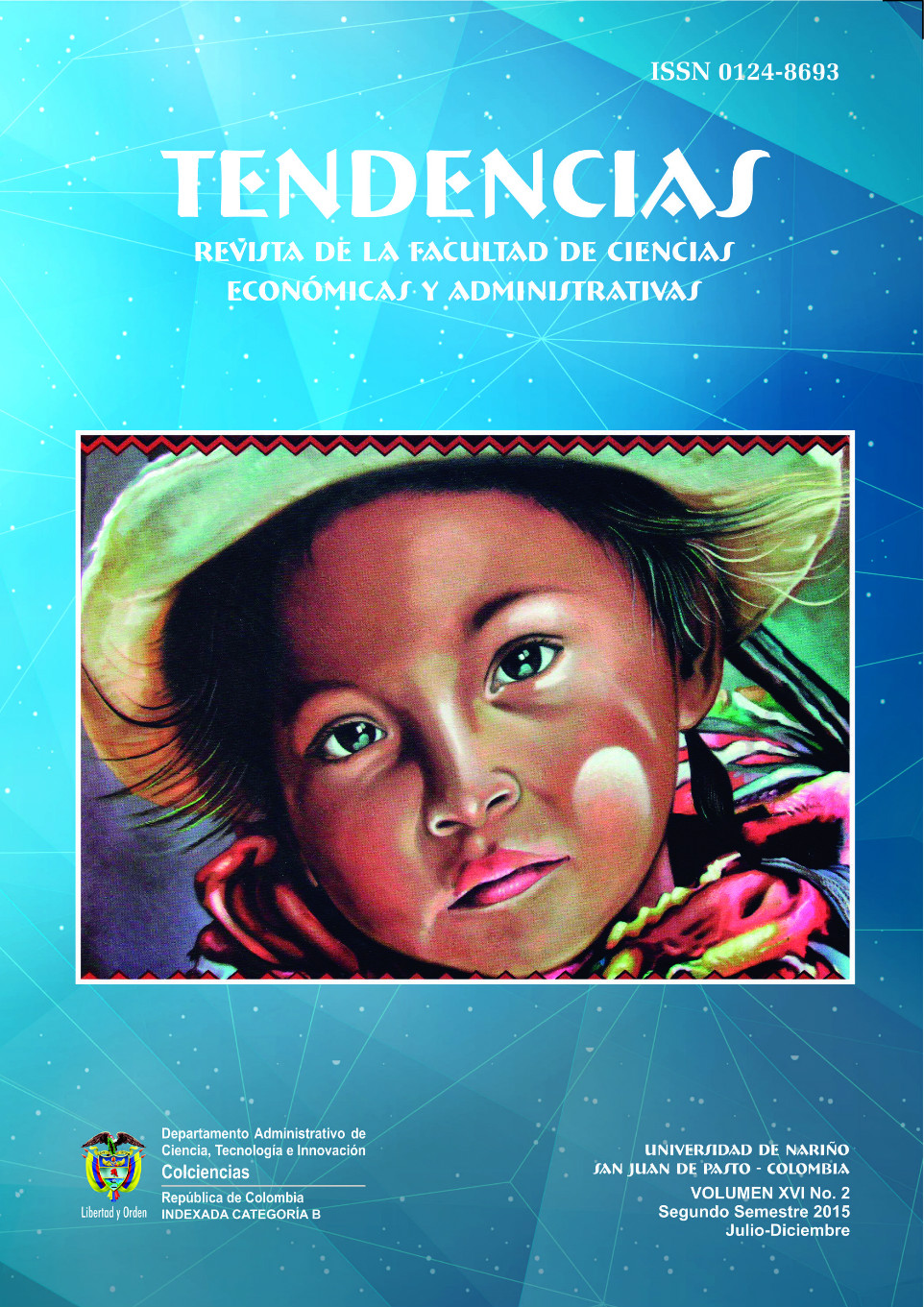Leak demand in the commercial sector Popayán, Colombia: an approach models logit
DOI:
https://doi.org/10.22267/rtend.151602.24Keywords:
Commercial Sector, Demand, Logit ModelsAbstract
The aim of this study is to determine the reasons why families of Popayan not buy goods and services in the local business sector and do so in other municipalities or cities. To achieve an incidental sampling and analysis is performed with discrete stochastic models logistic variable is implemented. Among other results, the study shows that the surveyed population is women who buy more frequently than men for out of town items such as clothing, shoes and accessories. Additionally, we find that a factor is the variety, followed by the prices, although this depends on the stratum to which they belong. Finally, it is concluded that the commercial sector must improve in areas such as customer service, hours of operation, among others.
Downloads
References
(1) CÁMARA DE COMERCIO DE CALI (2014). Apunte Económico. Unidad Económica y de Planeación. Cali. 5p.
(2) CÁMARA DE COMERCIO DEL CAUCA (2014). 200 Empresas Generadoras de Desarrollo en el Cauca. Popayán. 47p.
(3) CÁMARA DE COMERCIO DEL CAUCA (2011). Estudio de Identificación de Potenciales Beneficiarios del Programa Formalización. 77p.
(4) CUESTA, Marcelino y HERRERO, Francisco (2010). Introducción al Muestreo. Working Paper. Departamento de Psicología. Universidad de Oviedo. 9p.
(5) DEATON, Angus y MUELLBAUER, Jhon (1980). Economics and Consumer Behavior. Cambridge University Press, Cambridge. 447p.
(6) DANE (2013). Índice de Precios al Consumidor. Comunicado de Prensa. 4p. [En línea] Disponible en: http://www.dane.gov.co/files/investigaciones/boletines/ipc/cp_ipc_jul13.pdf
(7) FERNÁNDEZ DE CASTRO, Juan y TUGORES, Juan (1998). Microeconomía. McGraw Hill. Barcelona. Primera Edición. 458p.
(8) FONDO SOCIAL EUROPEO Y SERVICIO ANDALUZ DE EMPLEO (2007). Estudio del Sector Comercial de Motril. España. 400p. [En línea] Disponible en: http://www.motril.es/index.php?id=1255
(9) GLIMCHER, Paul y FEHR, Ernst (2013). Neuroeconomics: Decision Making and the Brain. Academic Press: New York. 560p.
(10) HOFFMAN, Douglas; BATESON, Jhon (2010). Services Marketing: Concepts, Strategies & Cases. South-Western. Mason, USA. Fourth Edition. 461p.
(11) JEHLE, Geoffrey y RENY, Phillip (2000). Advanced Microeconomic Theory. 2nd Edition. Addison Wesley: Reading.672p.
(12) MINISTERIO DE AGRICULTURA, ALIMENTACIÓN Y MEDIO AMBIENTE DE ESPAÑA (2006). Hábitos de Consumo de Alimentos en España. Madrid. 398p. [En línea] Disponible en http://www.magrama. gob.es
(13) MIRA, Bibiana (2012). Hábitos de Consumo en Colombia. Suramericana de Seguros [En línea] Disponible en: http://www.sura.com/blogs/mujeres/habitos-consumo-colombia.aspx
(14) NICHOLSON, Walter (2000). Teoría Microeconómica: Principios Básicos y Ampliaciones. Thompson. Madrid. Sexta Edición. 745p.
(15) ORMET (2013). Informe de Diagnóstico del Mercado de Trabajo de Popayán. Observatorio Regional del Mercado de Trabajo. Ministerio de Trabajo, Departamento para la Prosperidad Social (DPS), Plan de Naciones Unidas para el Desarrollo (PNUD) y Universidad del Cauca. Popayán. 97p.
(16) PINDYCK, Robert y RUBINFELD, Daniel (1998). Microeconomía. Prentice Hall. Madrid. Cuarta Edición. 630p.
(17) SIERRA, Olga; SERRANO, Sandra (2002). “Patrones y hábitos de consumo en Baja California”. En: Comercio Exterior. Vol. 5, Numero 8. Agosto. Ciudad de México, México, pp. 701-708.
(18) TALAYA, Esteban; GARCIA, Jesús; NARROS, María; OLARTE, Cristina; REINARES, Eva, SACO, Manuela (2008). Principios de Marketing. ESIC Editorial. Madrid, España. Tercera Edición. 815p.
(19) VARIAN, Hal (2000). Microeconomía Intermedia: Un Enfoque actual. Editorial Alfa Omega. Colombia. Quinta Edición. 726p.
(20) USÍN, Sandra (2014). Experiencia de Compra de los Consumidores de Centros Comerciales de Vizcaya. Tesis Doctoral. 567p. Universidad Politécnica de Valencia. [En línea] Disponible en: http://hdl.handle.net/10810/12458.
Published
How to Cite
Issue
Section
License
Those authors who have publications with this journal, accept the following terms:
This journal is licensed under a Creative Commons Reconocimiento-NoComercial 4.0 Internacional License. The articles can be copied, distributed, adapted and communicated publicly, as long as the credits of the work are recognized and the respective source is quoted. This work can not be used for commercial purposes.
To increase their visibility, documents are sent to databases and indexing systems.
The content of the items is the responsibility of each author, and does not compromise in any way, journal or institution.







































